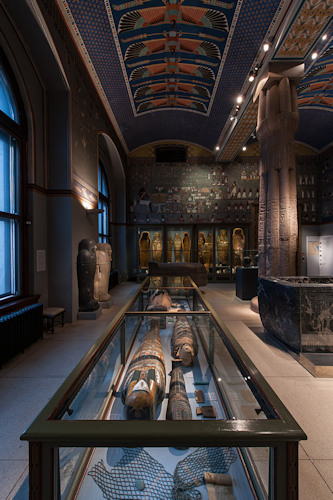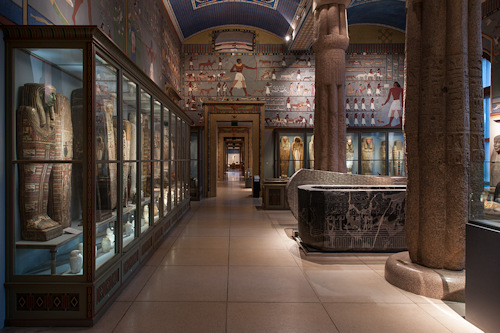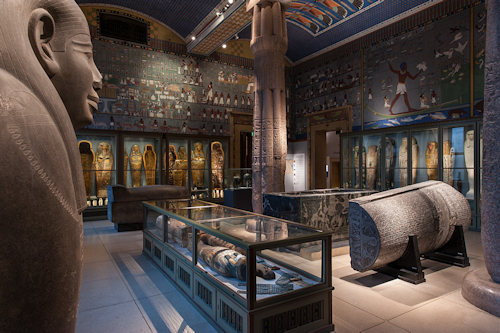
No museum of art history is complete without a sarcophagus or two from the time of the pharaohs. And, true to form, galleries 1 to 9 in the Kunsthistorisches Museum cover ancient Egypt from around 4,000 BC to the early Christian era.
- Small, but significant, selection of exhibits taking you through the life, culture and religion of the era
- Galleries walls, ceilings and columns themselves often follow an Egyptian theme
- Book your museum tickets* online to avoid counter queues
- See also:
Egyptian artifacts
(The opening gallery (I think) in the Egyptian and Near Eastern Collection with its marvelous presentation environment; press photo ©KHM-Museumsverband)
The Egyptian collection offers an immersive experience, with the walls, ceilings and even door arches of several rooms matching the topic in terms of design and decoration.
Even without understanding anything, a brief wander through the displays gives you an impression of the obsessions of the time (cough – the afterlife – cough).
There’s also something strangely reassuring about seeing all those symbols, shapes and objects we’re so familiar with from popular films.
- Sphinx? Yep.
- Regal-looking man with a long, narrow beard? Yep.
- Hieroglyphics? Yep.
- Jackal-headed images? Yep.
- General feeling there must be a lot of very empty archaeological dig sites in Egypt? Yep.
Gallery 1 already confronts you with mummies, sarcophagi, scarabs, coffins and those canopic jars that stored internal organs for the afterlife.
The giant sarcophagus of Pa-di-pep from the late-period 26th dynasty leaves a particularly strong impression.
Incidentally, nobody cunningly aged the gallery’s main columns to look weathered by centuries of Egyptian sun – these are originals from excavations in Alexandria.
Further highlights

(Another gallery view of the Egyptian and Near Eastern Collection; press photo ©KHM-Museumsverband)
As a non-expert, here’s what else caught my attention:
- Gallery 2 takes you “inside” (literally) a mastaba or large tomb. You go into the actual cult chamber, which they shipped over from its location in Giza in 1914.
Ka-ni-nisut, the original occupant of the tomb, was a high-ranking civil servant from around the 4th/5th dynasty, some 4,500 years ago. Close your eyes late at night and you might catch whispered mutterings about the price of limestone and paper clips.
- Gallery 3 has a collection of Shabti, which look a little like miniature Oscars. These were left in tombs to take on manual tasks for the deceased in the afterlife.
Leaving nothing to chance, the Shabti sometimes also included model overseers to manage the labourers. You face enough problems in the afterlife without having to worry about rebellious workers.
- Gallery 5 covers funerary literature: the scrolls, wall inscriptions and similar containing the spells and texts required to ensure safe passage into the afterlife.
After you go in, look to the left for an original papyrus showing a pictorial guide to the underworld.
(If you want more documents from ancient Egypt, try the Papyrus Museum in the National Library.)
- Gallery 4 leads off 5 and covers magic and gods (another big deal in ancient Egypt).
For an illicit snigger, check out the display cabinet on your right as you enter for a “protective figure” of a man with a certain portion of his anatomy accentuated to twice his body size.
Also check the central display for various mummified animals, including a cat, crocodile, fish and snake.

(And another gallery view of the Egyptian and Near Eastern Collection; press photo ©KHM-Museumsverband)
There’s even a tiny coffin built for a shrew, a divine animal representing the sky god Horus. Which might have led to some teasing from his arch-enemy Set, if Horus wasn’t more usually associated with the falcon.
- Gallery 6 shows that ancient Egypt had more to offer than just worrying about the afterlife and keeping the gods happy, with displays of clothes, pottery and jewelry from the time.
The collection ends with galleries 7 to 9 and various busts, statues, temple items and similar.
In 7, for example, you find false doors that acted as symbolic gateways between the present and the hereafter. Be sure to find the unusually lifelike statue of Sebek-em-saf from 1700 BC. “Lifelike” because he was a chubby fellow and the statue shows it. Clearly a man of wealth and appetite.
In 9, look for the 2nd century BC sarcophagus of Pa-nehem-isis, a priest. Almost every surface is inscribed with symbols. It seems it remained unfinished, and I have visions of Egyptian stonecutters hammering away desperately, trying to meet their contractual deadline.
(Each time I visit, more and more English appears in the information posters and item labels. But some areas may still be largely German-only.)
Next up on your tour of the Kunsthistorisches Museum: the Greek and Roman antiquities.
